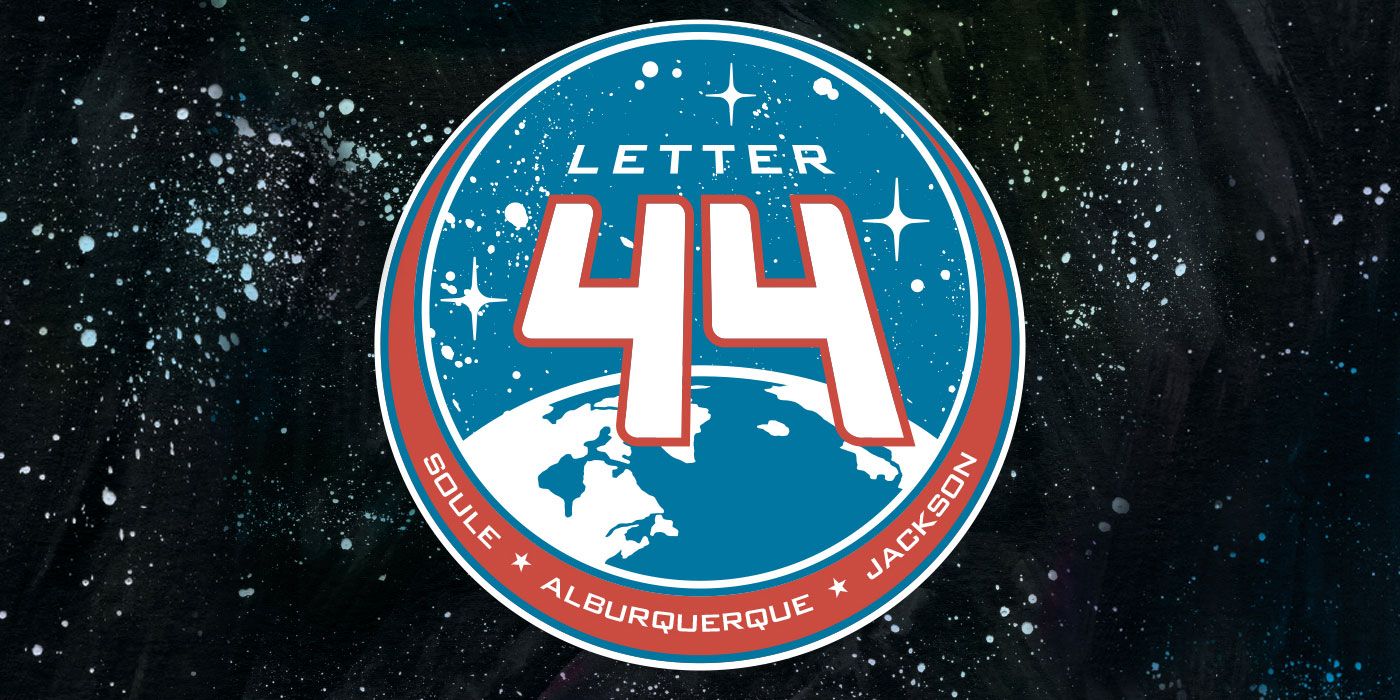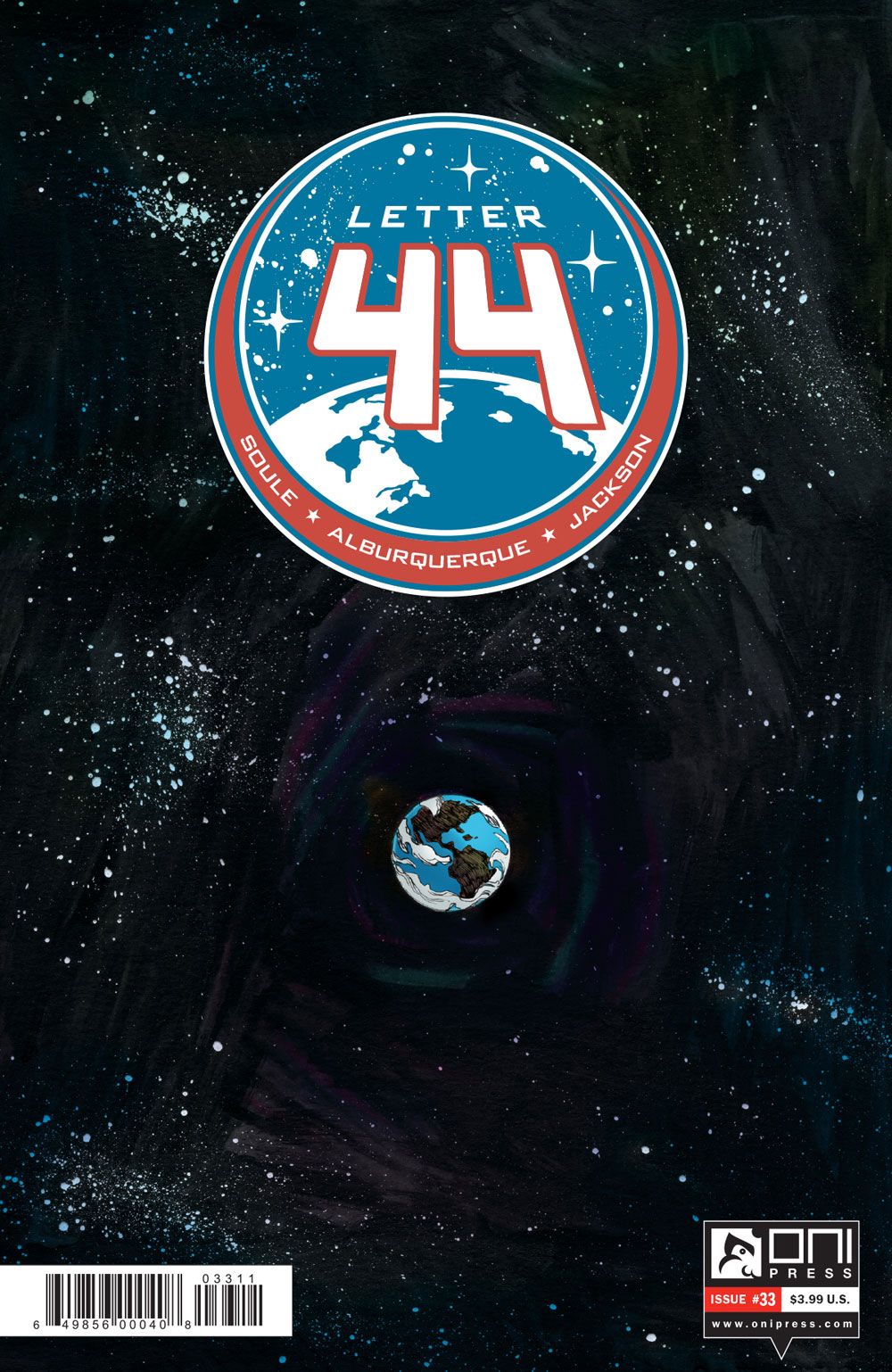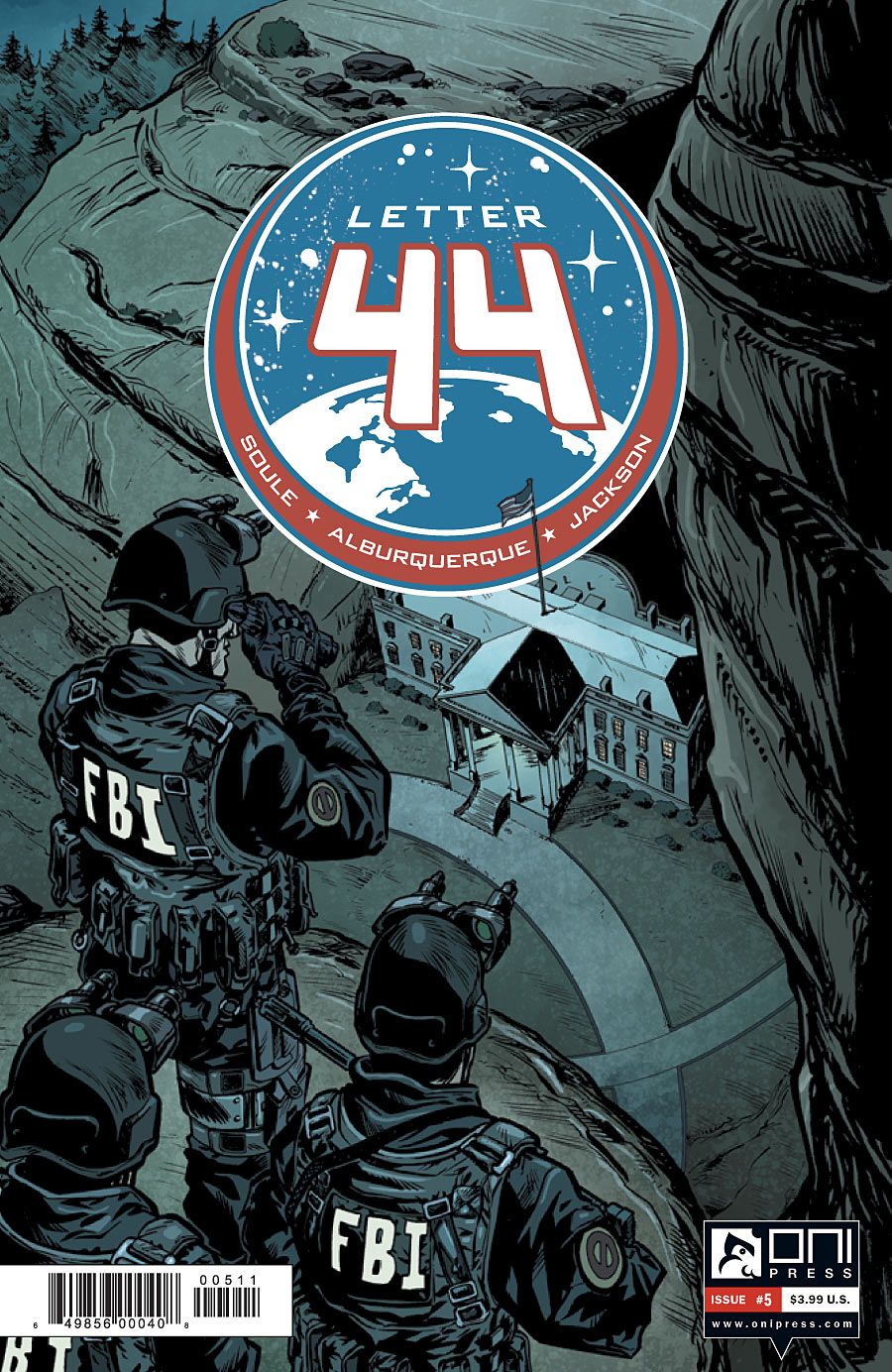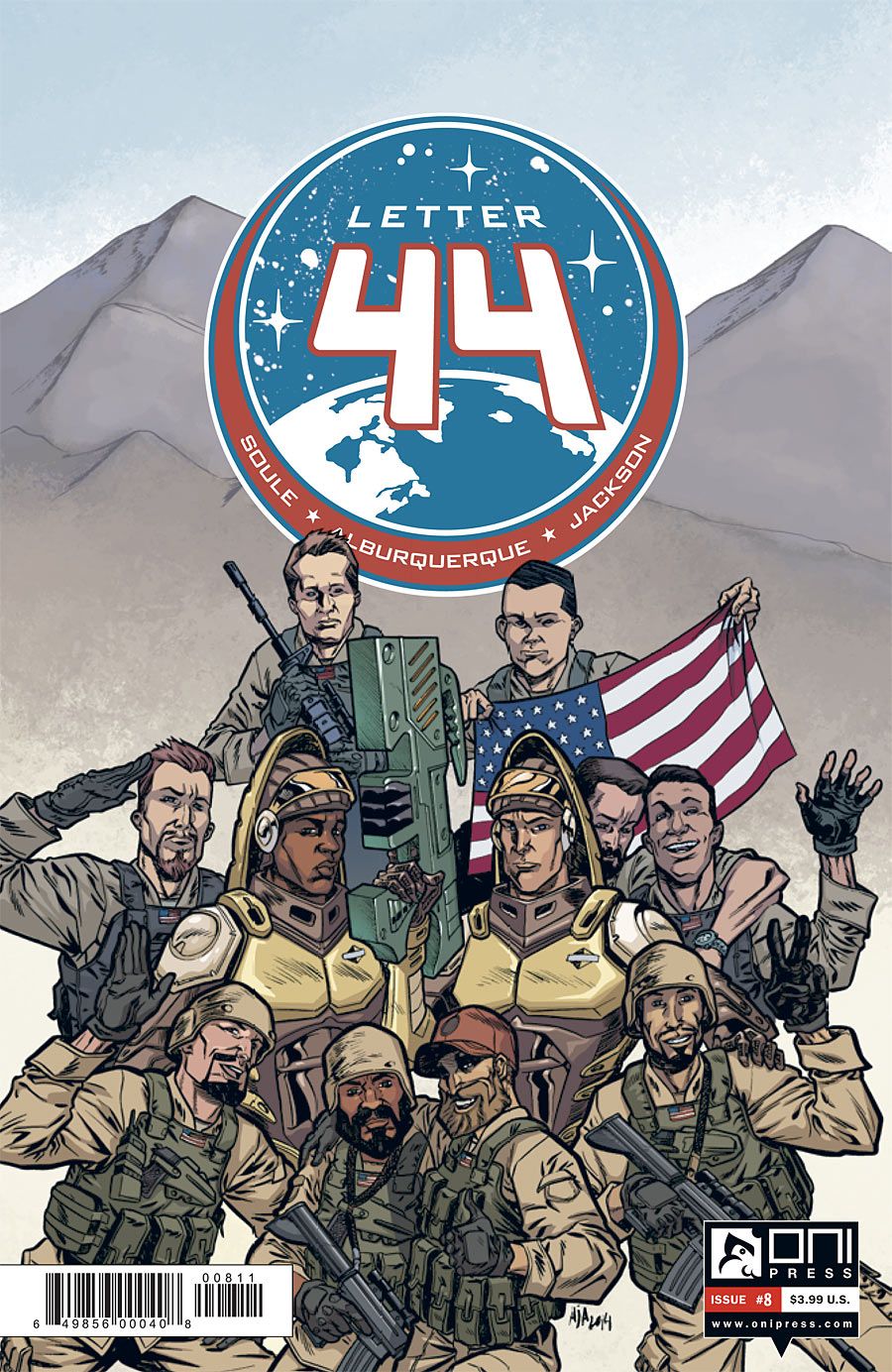SPOILER WARNING: This interview contains spoilers for "Letter 44" through #29. Issue #30 is on sale now.
With the discovery this week of seven Earthlike planets in the Trappist-1 system, the odds of finding intelligent life outside our solar system may have grown just a little bit bigger. But back on Earth, how would a major world government react if it found definitive proof of alien life?
Launched in late 2013 from Oni Press, "Letter 44" by Charles Soule and Alberto Jimenez Alburquerque tells the story of incoming U.S. President Stephen Blades, who learns in a letter from his predecessor, President Francis Carroll, that all of the Carroll administration's efforts for the past seven years have been focused on one thing: preparing to repel an invasion from beings they've deemed "the Builders" who are constructing a massive device in the asteroid belt between Mars and Jupiter. President Carroll had also launched a manned mission to the asteroid belt to further investigate the Builders, and three years into their mission they make contact -- with unexpected and often baffling results.
As the series progresses, political machinations on Earth and the astronauts' fight for survival in space combine to paint a complex picture of humanity. Now, as "Letter 44" nears its conclusion in issue #35, the parallel storylines are set to collide with the fate of humankind hanging in the balance. CBR spoke with Alburquerque and Soule about the series to date.
CBR: I think the thing that sold me on "Letter 44" from the start is that it seemed to be asking, "What would it take for all of President Bush's actions to make sense?" But from there you get into much more subtle political intrigues. President Blades and former President Carroll are clearly not Obama and Bush, but how do you use their contrast to show different approaches to power and responsibility?
Charles Soule: The reason they felt like Obama and Bush in that first issue and, to some degree, the first arc, was to give readers an immediate sort of hook and entry point; to say, "wouldn't it be fun if it was something like this?" But the truth is that every incoming president -- and we see it with the guy we have, we saw it with Obama -- when they come in on Day One they realize the job is extremely different from what they thought it was going to be. Campaigning is one thing and governing as president is a completely different proposition. You remember those photo shoots from the day that Trump went into the Oval Office and met Obama -- he was dying, from what he had heard on just that one day!
I think that the contrast between Blades and Carroll as the story goes on is, they are both people who feel like they know how to save the world, and they have very different approaches to what that means. Carroll is convinced that the world is one way: the aliens are going to destroy us, they're going to come down and fight and we need to defeat them, we need to be ready for that. Whereas Blades says, we don't know anything about this, let's do a little research and wait and see before we start militarizing the entire world, starting wars and things like that.
I also wanted to show, over the course of the series, now that we're almost at the end, you can see that a president has a lot of power in very specific ways, but they're not omnipotent, they can't do everything they want to do. So despite the best efforts of Blades to take this wait-and-see approach to see if we can learn more and maybe cooperate with these beings, events overtake him and the world has its own kind of engine that moves it forward. I don't care what your political office is, it's going to do what it's going to do.
That was the contrast I wanted to explore. The president who has the office is trying to perform to the best of his ability, but even with all that power, there's only so much he can do. Then you have another president who is so desperate to regain that power, the former president who thinks he never should have left office and if the damn Constitution hadn't got in his way he would have stayed. They're both good presidents. They're both Americans, they both believe in what they're doing. They both can say they're amazing U.S. presidents but it's up to the reader to decide who's actually any good.
The current arc sees the two presidents each selecting a small number of people -- 666! -- to survive the imminent destruction of Earth. How do their choices reflect their own priorities and worldviews?
Soule: To give context to anyone who hasn't read the series, as the story continues, we start with the new president discovering that there's this alien construction project in the asteroid belt. The former president, the outgoing president, had known about it for seven years, and he's done a lot of things to prepare the world for this, mostly militarization because [he believes] these things are here to kill us. The new president is in kind of a wait-and-see position. But as the story moves forward, things get darker and darker and darker, and it seems like it really is going to be the end of the world. Each one of the two presidents gathers a group of people into that hypothetically will be able to survive this world ending apocalypse. So Carroll, the former president, gathers together a bunch of "true believers" in a bunker inside of a mountain. His feeling is that these are people who are going to worship him as an absolute power, as a god, that's the difference between what he does and what Blades does. Blades brings together 666 people who are hopefully the creme de la creme of humanity, geniuses or young kids who have a lot of potential ahead of them. These are people who are not about him, they're about humanity. That's the core difference between Carroll and Blades: Blades is thinking about the world and humanity, whereas Carroll is ultimately motivated by thinking about himself.
Blades chose to protect his son, but not himself or his wife, whereas Carroll gave himself a spot.
Soule: Carroll's family is gone; there's a point when you learn a little bit more about Carroll's backstory and you find out that his wife died, and his wife was the thing that was keeping him normal or human or connected to the human race. After his wife dies, he kind of goes a little nuts. He has no family. Blades has a wife and a son, and he doesn't put his wife in but he does put his son in. He can't not do it, he can't sentence his son to death.
Alberto, you get to draw some fantastic space sequences and more down-to-earth scenes of very human scheming. Are there challenges associated with illustrating for these sort of parallel storylines, making them feel like parts of a whole?
Alberto Jimenez Alburquerque: Both have their own challenges on their own. Space scenes are always hard to draw because, well, we've seen astronauts and weird aliens in sci-fi movies, but I always try to give it my own spin. Also, in the Earth scenes there's a lot of conversations, a lot of politicians talking, and that's challenging because readers can get the action through the dialogue and it's interesting and engaging, but I want to make sure the images work, too. Then mixing them together, finding a way to tell both stories and integrating it in one issue, it's hard to jump from one style to the other without making the reader alienated. So I tried to keep it together.
You also get to mix a lot of technology, as well as some surreal, fluid worlds.
Alburquerque: Charles told me at the beginning that the Earth things should be possible, like something we could develop in 10-15 years. And then where we got to see the alien technology, he had this idea in mind of the fractals, and from there he told me I could do whatever I want, I could explore a little more. I had a blast.
There have also been some very human moments of family drama, in space. At the beginning you set up an unusual family situation for a crew left to their own devices in deep space, I'd be curious to hear you both talk about how that's played out through all of the characters.
Soule: Sure. There were nine astronauts on the Clarke when it was sent out into space, and when we open in issue #1, we realize there are only eight. That implies that obviously something happened, and they're not telling Mission Control. Mission Control doesn't know that. They're just like, oh, he's in the bathroom whenever they call. They've covered up that one of them is gone for some reason. Not only that, but the men and women on this ship have entered into this sort of polyamorous family where anybody can have sex with anybody else on the ship if that person says yes. Nobody has any hold on anybody else, there are no relationships, and they did this to sort of avoid conflict on the ship. Which sets up this interesting idea, at least to me, of what humans need and whether jealousy erupts in a situation like that and how very intelligent, very smart people can try to avoid some of the emotional entanglements that affect everybody. This is the solution they came up with; whether it's good or not, well, as the story continues you can draw your own conclusions.
Part of the core of the whole series, one of the most significant parts of the book, is that the leader of the science team, Charlotte Hayden, becomes pregnant. She has a child, a little baby named Astra, during the mission. That really it like a family -- now there is a second generation that they have to look out for. But they're in this situation where they all expect to die at any moment -- it's the worst possible environment to bring a child into, and they do it anyway. Why they did that, how they deal with it, how Astra will develop as a character -- it's been awesome because it's given me the chance to write all of these emotional beats of all different kinds. Jealousy, anger, love, sadness. And Alberto, thank goodness, is very, very capable of drawing all that stuff. I know he does not enjoy drawing Astra's various adventures [Alberto laughs], she's the hardest one I guess. It's really great to have an artist who, if I ask for a very subtle kind of emotion, he gets it right every time.
Albuquerque: I appreciate that. Drawing Astra, it's not that I don't like it -- it's a hard task to draw a little baby that talks and has heart attacks… it's challenging, every time. I like drawing her more now that she's a little older and can walk a little and move more like a person. But at the beginning I struggled a little bit with baby Astra. She's a cool character, but it's not easy.
And all the range of emotions, Charles is really good at writing emotional scenes. There are a lot of scenes throughout the series that touch you, and you can relate to that. A father and mother really caring about their kid, and all the sacrifices you make for your own people and all that. Drawing subtle emotions is a hard one to do but it's part of the joy of the job. It would be very boring to draw people who are all the time smiling or all the time angry. It's pretty fun to be able to explore human expressions and acting through these characters and all the emotions that Charles writes so well.
The weight of responsibility and the consequences of major decisions have come up again and again, and now it looks like the crew of the Clarke have made a pretty major miscalculation in deciding to attack the builders. How do they move forward from here?
Soule: One of the big themes of this story is the way people misunderstand each other, the way they aren't able to see things from another person's perspective, or they make assumptions about what other people are doing. That is compounded when you bring into the story an alien race, a race that evolved in a completely different way, that has completely different concerns and completely different way of communication. One of the biggest things that I think we would have difficulty with if we ever encountered an alien race is just being able to understand what the hell they want, what motivates them. We're motivated by what you could call the basic human desires or needs: shelter, water, companionship. Survival, and then if you're evolved enough it starts to move beyond yourself to family, protecting and keeping them safe, and then your community, and then maybe the world. All of those things at various levels, and they all kind of make sense, you understand how they work from a human perspective. If we met alien life? Let's take a mayfly. A mayfly is a larva underground for a long time, then they emerge, they have one day of frantic sexy mating time, and then they die, and that's it. So what they would consider important in their lives is very different -- we just couldn't relate to it.
I wanted to write a story where that theme was very strong. There's a lot of times where characters who could easily solve a problem if they tried to understand each other better, don't. Through the whole thing, the humans, until very close to the end, don't understand what the Builders were doing, why they were doing it, why they were here. They make decisions that seem correct at the time, like it's impossible to think of any other way to do it, so they make these choices that have very dramatic effects. And it's all born out of that lack of understanding. Makes for some great cliffhangers and drama, for sure.
Would you say the Builders are also guilty of not trying to understand where the humans are coming from?
Soule: Well, as we learn, the Builders have been on a journey for billions of years trying to complete their mission, which I'm not going to spoil too much. They've tried to do what they're trying to do for such a long time that the idea that this upstart, relatively new, incredibly young intelligent race is going to have anything new to tell them or teach them, they find it ludicrous. There's this great idea in other science fiction spaces that, because of the way we evolved, we see the world and receive the world in a certain way. Your mind gets set in these patterns about the way that things can work, like what a screwdriver can be used for. But if you grew up in a different tradition, or if you grew up with a different anatomy, a screwdriver might work as an entirely different sort of tool. If we had different kinds of teeth, a screwdriver could be a toothbrush. You get the idea.
There's a point in the story where, because of those evolutionary differences, the humans of the Clarke discover something about the Builders' technology that they never could have seen. It's just the sort of basic thing that the Builders always missed for billions of years. That ends up being a very significant plot point to the story.
So yeah, the Builders don't really try to understand things, either. They know that humans are an intelligent race and that's valuable in the universe, but beyond that humans are just the next ones in the road, pretty much.
So… now that you're wrapping up "Letter 44," is there any chance you'll do a reboot for "Letter 45?"
[Both chuckle]
Soule: You want to tackle that, Alberto?
Alburquerque: Sure, maybe?
Soule: It would just be such a different story. Maybe someday we'll do a parody issue, like "what would have happened?"
Alburquerque: That could be fun.
Soule: What would be fun is if we just did one issue that was like "Letter 25," or "Letter 16" and it's Abraham Lincoln. Picking different presidents at different times and how they would react to something like this. Give them each five pages. That actually sounds kind of fun!
Albuquerque: That could be really cool because it would allow me to draw different times.
Soule: Like what would happen if this happened during World War I? Or in the 1700s?
Anything else you'd like to add before we go?
Soule: I'm just so happy that people are still reading the series. That Alberto and I have been able to tell the story to its end. The series will wrap up with issue #35, which will come out in I think May or June. I'm extremely proud of what we've been able to do with it, and if people haven't checked it out yet, I hope they do.
Albuquerque: It's really amazing that an independent book like "Letter 44" has made it through almost five years of work and we have been able to tell the whole story the way we wanted to do. I'm really proud of what we have done. I'm happy that this series brought me to Charles, meeting him is awesome. I think I've learned a lot drawing the whole series. It's really cool. People seem to like it here in Europe, in France and Spain people love it. I want to find out what happens in the end and I think readers of the series want the same thing, too!




